tags: ecology, marine biology, conservation biology, endangered species, habitat preferences, Northern Bluefin Tuna, Atlantic Bluefin Tuna, Thunnus thynnus, Yellowfin Tuna, Thunnus albacares, fisheries, PLoS ONE, researchblogging.org,peer-reviewed research, journal club
A recently published study, intended to provide data to commercial fisheries in the Gulf of Mexico so they maximize their catch of Yellowfin Tuna, Thunnus albacares, whilst avoiding bycatch of critically endangered Atlantic (Northern) Bluefin Tuna, Thunnus thynnus, suggests that the Deepwater Horizon oil leak may devastate the endangered Atlantic bluefin population, causing it to completely collapse or possibly go extinct.
"The population has declined 80 percent to 90 percent of what its original spawning biomass was," said the study's senior author, Barbara Block, a MacArthur Fellowship "Genius Award" Laureate and marine biologist at Stanford University.
Even though it has been illegal to catch Atlantic bluefin tuna in the Gulf of Mexico for more than 20 years, they are accidentally caught by commercial yellowfin tuna, swordfish and marlin fisheries. To avoid bycatch, it is essential to identify the spatio-temporal locations of bluefin so commercial fisheries can modify their techniques to avoid them.
It is generally known that migratory bluefin enter the Gulf of Mexico to spawn each March and stay through June before returning to the North Atlantic Ocean to forage. These giant fish, which can live to be 30 years old and weigh more than 1,400 pounds each, are thought to be similar to salmon; returning to the same area where they were born to spawn. But it is not known with certainty when nor where these fish are, so avoiding them whilst targeting their close relatives, yellowfin tuna, is not a simple matter.
A team of scientists designed a series of studies to remedy this lack of precise information. Their studies relied on two data sources, both of which required them to .. go fishing. The first data source was catch and effort data reported by fishery observers on commercial longline vessels in the Gulf of Mexico from 1992 through 2005. The second data source was the researchers' own catch and effort data collected during six scientific longline cruises in the Gulf of Mexico between 1998 and 2002, as part of their Tag-A-Giant program. The Tag-A-Giant fishing efforts were conducted for the purpose of placing electronic tags on bluefin tuna, which were then released (using methods shown on this video):
This video, filmed by videographer Bill Hitchcock in January 2009, shows Stanford University's Dr. Barbara Block electronically tagging one of the largest Atlantic bluefin tuna ever tagged off North Carolina. To date more than 1,000 electronic tags have been deployed on Atlantic bluefin by the Block Lab's Tag A Giant program, and the results are helping us to understand how these animals use their open ocean habitat.
 The researchers' pelagic longline sets (n =112) consisted of 188±95 circle hooks baited with either squid or sardines, placed at depths of 100-200 meters (1999) or 40-120 meters (2000-2002). Circle hooks (pictured, right) are designed to decrease wounding and release mortality, while also increasing the chance of landing the fish once they take the bait. Both the commercial fisheries and Tag-A-Giant sets were made in the US exclusive economic zone from 86.06oW to 94.90oW in longitude and 26.67oN to 28.5oN in latitude (Figure 1):
The researchers' pelagic longline sets (n =112) consisted of 188±95 circle hooks baited with either squid or sardines, placed at depths of 100-200 meters (1999) or 40-120 meters (2000-2002). Circle hooks (pictured, right) are designed to decrease wounding and release mortality, while also increasing the chance of landing the fish once they take the bait. Both the commercial fisheries and Tag-A-Giant sets were made in the US exclusive economic zone from 86.06oW to 94.90oW in longitude and 26.67oN to 28.5oN in latitude (Figure 1):
Figure 1. Locations of pelagic longline sets in the Gulf of Mexico. Each grey square indicates where one or more longline sets were recorded by fishery observers on commercial longline vessels (n = 2662 sets) within the 1 x 1o area (we are unable to show locations of individual sets due to privacy concerns). Each red circle indicates a single longline set during our laboratory's cruises on longline vessels targeting bluefin tuna for tagging (n = 112 sets).
DOI: 10.1371/journal.pone.0010756
During these time periods, a total of 288 bluefin and 6633 yellowfin tuna were captured by 944 fishery and 112 researcher longline sets in the Gulf of Mexico (Figure 2; note that the axes are different sizes):
Figure 2. Numbers of bluefin and yellowfin tuna per longline set. Histograms show the number of (A) bluefin and (B) yellowfin tuna caught in each longline set.
DOI: 10.1371/journal.pone.0010756
These data provided the research team with a general idea as to where these two species are located in the Gulf of Mexico. When the researchers analyzed their catch/bycatch data to determine when bluefin and yellowfin tuna were present in the Gulf of Mexico, they found that bluefin tuna are highly seasonal, whilst yellowfin are not (Figure 3):
Figure 3. Mean and relative bluefin and yellowfin tuna CPUE. Circles indicate monthly mean (A) catch per unit effort (CPUE) of bluefin (closed circles) and yellowfin tuna (open circles) in the Gulf of Mexico, and (B) mean ratio of number of bluefin to 100 yellowfin caught. Error bars indicate 1 sd (based on 1000 bootstrap samples).
DOI: 10.1371/journal.pone.0010756
The above data show that the majority (87.4%) of the bluefin tuna bycatch occurred during their breeding season that occurs annually from March to June, peaking in April (0.472±0.075 fish per 1000 hooks), whilst no bluefin were caught between July through November (Figure 3A). In contrast, whilst yellowfin tuna numbers were modestly variable, with the highest numbers being caught in July (12.8±0.84 fish per 1000 hooks) and the lowest numbers in March (5.48±0.34 fish per 1000 hooks), yellowfin were consistently present in the Gulf of Mexico throughout the year. Comparisons between the rate of bluefin bycatch to yellowfin catch showed this ratio was highest for the month of April (6.4±1.0 bluefin caught per 100 yellowfin) (Figure 3B).
But precisely where are bluefin tuna located? Are they present everywhere throughout the Gulf of Mexico, or do they prefer specific locations? Once again, bycatch data show that bluefin tuna are much more specialized in their habitat preferences (and therefore, have a more limited range; Figure 4A) than are yellowfin tuna (Figure 4B):
Figure 4. Spatial variability of bluefin and yellowfin tuna CPUE. Catch per unit effort (CPUE) of (A) bluefin and (B) yellowfin tuna are indicated by size of circles. Crosses indicate locations where more than 5000 hooks were set but no fish were caught.
DOI: 10.1371/journal.pone.0010756
"The bluefins' habitat requirements are relatively exact so we can predict with reasonable accuracy where bluefin tuna are likely to be spawning at any given time based on oceanographic data continually being gathered by satellites and weather buoys," said lead author Steven Teo, a conservation biologist and postdoctoral scholar at the University of California at Davis.
"Both catch data and electronic tags indicate the Gulf of Mexico along the continental shelf is the preferred habitat of this majestic fish," agreed Dr Block.
Not only were yellowfin tuna caught in some areas where bluefin tuna were not caught, but yellowfin were caught in most areas in the Gulf of Mexico throughout the year, whereas bluefin tuna were primarily caught off the continental shelf of the southern United States in relatively deep waters, and only at specific times of the year. Latitude also strongly affected bluefin range but longitude did not (data not shown): bluefin catches were primarily restricted between 25 and 28oN.
"This is in stark contrast to yellowfin tuna, which exhibit much more generalized environmental preferences," Dr Teo added.
The research team used their data describing the habitat preferences and spatio-temporal distributions for bluefin and yellowfin tuna to develop a mathematical model to predict where bluefin and yellowfin tuna might be at a given place and time. Their model identified two main regions in the Gulf where bluefin are found; one in the eastern Gulf of Mexico to the north of the Loop Current, and the other in the western Gulf of Mexico. Both regions are along the slope where the shallow continental shelf depth plunges rapidly to the deep sea (Figure 8):
Figure 8. Expected probability of catching bluefin tuna. Colors indicate the expected probability of catching one or more bluefin tuna in the Gulf of Mexico on 15 May (A) 2002 and (B) 2005. Circles indicate actual relative bluefin tuna CPUE for May 2002 and 2005. Crosses indicate locations where at least one longline set was deployed but no fish were caught.
DOI: 10.1371/journal.pone.0010756
It is here, where warm Gulf waters meet colder seafloor currents where cyclonic eddies are formed. Cyclonic eddies are circular, swirling areas where warm and cool gulf streams circle around each other. A counterclockwise flow of oceanic water in the northern hemisphere is a cyclonic eddy: the center of the eddy is comprised of cool, nutrient-rich waters and is lower in height (by a few tens of centimeters) than the outer lying waters. The hot-bodied bluefin tuna preferentially spawn in these rich, cool waters.
The team's findings indicate that it is possible to utilize spatio-temporal management techniques to avoid bycatch of critically endangered Atlantic bluefin tuna on their breeding grounds. The yellowfin tuna fishery could simply utilize other areas in the Gulf of Mexico during the bluefin breeding season.
"The giant bluefin only show up for about a month, and this is the time they show up," said Dr Block. "Bluefin tuna are moving to the Gulf of Mexico exactly right now to spawn."
But tragically, Dr Block continued, the Deepwater Horizon oil spill is centered in one of the bluefin's preferred breeding areas. "Many of the tuna go exactly to that region."
Further, when you compare the location of bluefin spawning areas to a video animation based on another group's oceanographic model that predicts where Deepwater Horizon's runaway oil is expected to go, you'll see that this is a looming crisis for the already seriously endangered Northern Atlantic Bluefin Tuna: the Deepwater Horizon oil rig is located in the middle of one of their preferred spawning areas. In fact, Dr Block recalls regularly seeing petroleum vessels when conducting her research in the area in the past.
According to Dr Block, until this leak occurred, it looked like the sushi craze was the fish's biggest threat. "Now, just when you need [the species] to have a nice spring so that it can spawn," she remarked, "you have this accident."
Even though these animated oceanographic models are meant to be predictive only, their predictions about where BP's oil is going are supported by other scientists' observations: bluefin larvae and young, which float near the surface of the water, are clearly in the path of the runaway oil.
"We're trying to get a look at these young fish and their abundance and their distributions before they may become impacted by the spilled oil," said Jim Franks, a senior research scientist at the University of Southern Mississippi's Gulf Coast research laboratory. Dr Franks and colleagues recently returned from a 12-day collecting trip in the Gulf of Mexico.
Larval bluefin tuna.
Image: Jim Franks, University of Southern Mississippi's Gulf Coast Research Lab.
"Where we found bluefin tuna larvae, those waters would ultimately have carried the young fish up into an area that was most likely impacted by the oil," Dr Franks reported. "I suspect the larvae and eggs won't be able to escape if they [encounter] oil.''
"Based on the magnitude and the location of the spilled oil, we think they are in a very precarious situation," Dr Franks concluded.
Even though a large adult female bluefin may produce as many as 40 million eggs, only a few will survive -- most are eaten by predators or destroyed by storms or other natural events. If oiled, the developing eggs or larvae will likely die. But chemical dispersants may also kill the eggs or larvae. Even if the dispersants don't kill them outright, since they reduce the surface tension of water, they will probably cause the eggs or larvae to sink to much deeper levels than normal, where they're less likely to survive.
"The most delicate stage of life is the larval stage of any fish, and any fish floating in oil is probably not a happy larva," agreed Dr Block, who was not on the cruise. "I would urge BP and others involved in this oil incident to invest in finding out the effect of this oil on the larval fish of North America."
"It's just depressing," added marine biologist Bruce Comyns, an Assistant Professor at the University of Southern Mississippi's Department of Coastal Sciences, who was on the voyage.
"You don't have to be a researcher, you can be just someone who has an interest in the environment," Dr Comyns continued. "We're not just talking about the surface being affected, we talking about the entire water column being affected."
But all may not be lost for Atlantic Bluefin Tuna, according to Molly Lutcavage, a research professor and director of the Large Pelagics Research Center at the University of Massachusetts Amherst. She recently spearheaded a project off the coast of Nova Scotia where she and her colleagues implanted 41 adult bluefin tuna with pop-up satellite tags. Even though that tracking data is preliminary, they suggest that bluefin may spawn at different times of the year, either in the Gulf (unlikely) or possibly in other locations.
"Many fish aren't entering the Gulf of Mexico, which supports the possibility very strongly that there are other spawning areas," Dr Lutcavage reported. "If that's the case, then the good news is that [bluefin] have much broader spawning areas than previously thought, so fewer larvae might be affected by the oil spill. That may be the only silver lining."
Of course, in view of each population's fidelity to their natal spawning areas, it still is possible that this oil leak will lead to the demise of the Gulf population of bluefin tuna.
In view of all these uncertainties, it is impossible to say for sure what this oil leak will do to the already dwindling bluefin population, but the effect of the oil and the poisonous dispersants on the more than 8,300 species of plants and animals in the region could be devastating. Scientists predict it will be years or decades before the true toll of this disaster will be known.
"There is a much larger disaster unfolding here environmentally than people realize," Dr Block warned. "There is a lot of focus on the Louisiana shoreline, but this is America's greatest fisheries nursery, and we've got to pay attention to what's going on immediately."
A schoal of Atlantic (Northern) Bluefin Tuna, Thunnus thynnus [larger view].
Source:
Steven L. H. Teo, & Barbara A. Block (2010). Comparative Influence of Ocean Conditions on Yellowfin and Atlantic Bluefin Tuna Catch from Longlines in the Gulf of Mexico. PLoS ONE, 5 (5) DOI: 10.1371/journal.pone.0010756.
Additional resources:
Tag-A-Giant Foundation offers a free brochure that describes the fish, their work and includes lots of colorful images and maps [PDF]
Large Pelagics Research Center awards $500 for archival tags implanted in Atlantic Bluefin Tuna [poster PDF]

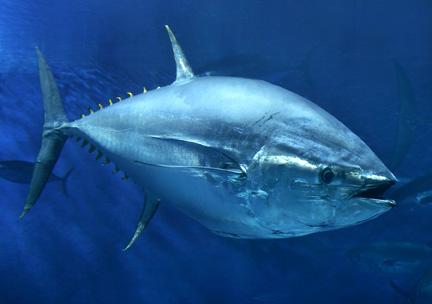
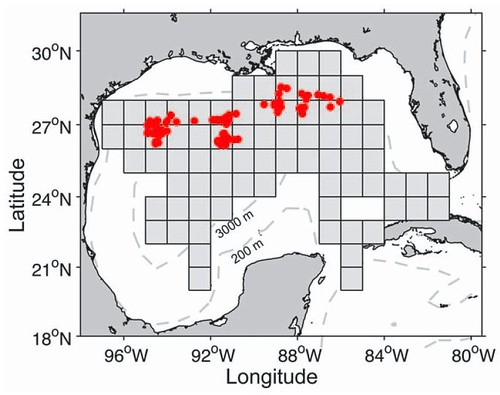
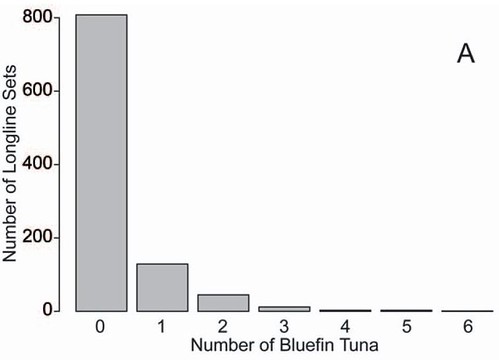
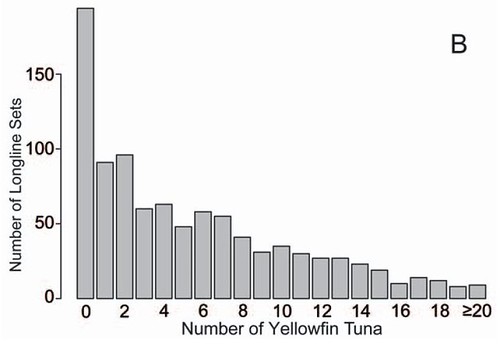
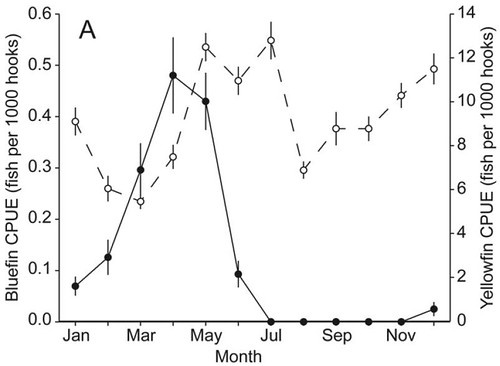



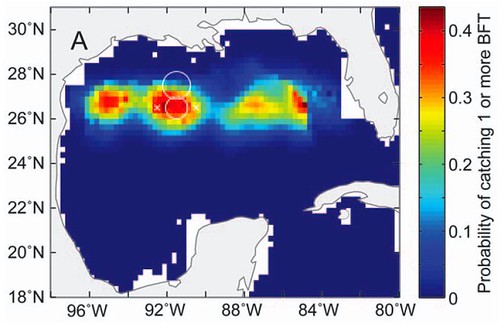

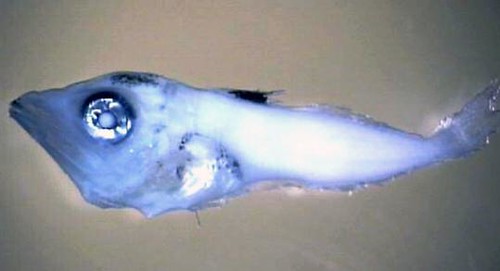
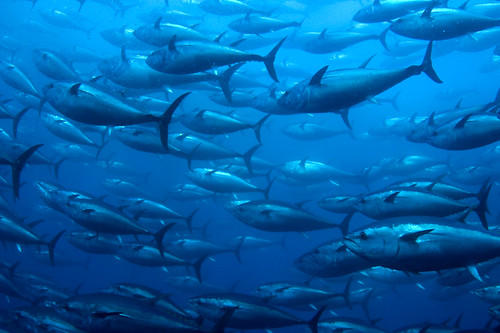
A very informative post on a tragedy in the making. I would also add that the ramifications obviously extend way beyond the gulf.
After the virtual death sentence on ABFT the other month, with stocks at roughly 10% or less of pre 1990, they are now heading for the Dodo collection.
The worst part is we see this happening and do basically nothing.
In perspective off the top of my head, (from memory), average catch sized fish were coming in at 4kg out in the Atlantic, where it is now a free for all - and these are some of the largest fish ever.
Very sad. The whole microbial ecology of the region of the gulf has been screwed at the worst possible time. I don't see much hope for anything in the plankton there this year, and probably not for a long time to come.
Oh, my Lord, will it never end? I despair.
It's hard not to use the language of extremists in the emotional reaction I have to events like this. On the internet you have to be taken at your word, so bandying around violent words is verboten. But god damn if it isn't tempting when people are messing up the world like this.
Invariably someone will come along in the thread to blame them damn Americans demand for oil. That isn't all of us (bus rider here) and even those of us in cars, if asked, would gladly pay more for gas if asshats in industry would prevent shit like this from happening.
No blame for the poor from me. I want to make BP executives the new Chicken of the Sea, dammit. I wanna bycatch some White Pasty Billionaires in my drift net. GRRRRAAAAAAH!
Humans just fuck everything up.
Yikes! I keep forgetting how big these things are!
Why oh why did this have to happen in Spring? Worst possible time what with the phytoplankton bloom kicking off the most productive season of the year and the ideal time for spawning of many species etc... Do you think a moratorium on any tuna fishing in the region for a year or so would help? Reducing the bycatch to 0 might help make up for this year's catastrophic mess... :s
Wow, I knew the situation was bad for the Bluefin, but this is really distressing. Thanks for such a well put together piece.
Invariably someone will come along in the thread to blame them damn Americans demand for oil. That isn't all of us (bus rider here) and even those of us in cars, if asked, would gladly pay more for gas if asshats in industry would prevent shit like this from happening.
Disclaimer: European view here, think of it as an outside observer psychoanalyzing a sick patient.
Well, yes, what you say is obviously a problem. But the US domestic oil price isn't the real issue. If people would pay 10x the price, oil would still be pumped, but it would simply be more profitable.
The issue is that massive amounts of oil are needed daily, therefore the US is extremely dependent on oil. This dependency is what drives oil exploration in the Mexican Gulf and other things such as the oil-focused US foreign policy, for example in relations with the Saudi royal family, geopolitics of the Middle East, and so on.
You don't cure a drug addict by asking more money for a drug. Instead, you try to remove the need or desire to obtain the addictive substance. If there is no need/desire for the drug, the drug will not be used.
Therefore to fix the problem, the dependency to oil must be diminished.
A notable detail is that the system has to be fixed from the demand-side. The diminishing of the oil dependency cannot be left to the market alone through price-modifying mechanisms, because by the time the market has eventually worked the situation through with all the lobbying, corruption, politics and other systematic inefficiencies, oceans will be poisoned with oil, the fish will be dead and coasts will be decorated by sticky tar-like blobs.
Oil isn't a drug. Asking more money for it does, eventually, drive people to alternatives. Asking less money for the alternatives helps too.
God gave us the tools... Once again we have failed another test.
Good perspectives, Anonymous and Nathan. Yes, frankly I'd be glad to see Americans lighten the demand. But being poor, I can see how our society is really set up from square one to keep poor people from having reasonable options.
Where you live - Can't afford to live close to work.
How you commute - Can't fight the moneyed interests
to get good mass transit in place.
What you buy - Can't afford the "fair trade," gotta
keep supporting child slavery down at the Walmart.
What you eat - Transfat-laden Chorizos from the
Cash&Carry are cheaper than health food.
How you survive - Paying a few thousand here, a few
thousand there for ER visits is - if you're lucky -
cheaper than health insurance.
The people with the power to bring real change to this country need to remember what the fuck ethics are. Or how about simply paying attention to the science? If we kill the oceans, we're gonna go extinct. Checkmate, Capitalism. Thanks for playing! You don't get another quarter.
I am enclosing a letter to a Louisiana based inorganic chemist working for the USGS, detailing a real fix for the oil slick.
Dear Mr. Rosenbauer,
I have looked for, but have not found any statement by the USGS as to a mineral cure to the oil slick. There are several. I suggest that it is time you folks weighed in on this catastrophe with the gravity of your organization's long history of respected science. The solution to the 'slick' will not be a material that floats and has to be re-collected...to difficult, too expensive. The solution will not be any 'manufactured product'...due to the magnitude of the slick, that too, would be too slow to 'gear up' and too expensive. That leaves only a mineral fix to the problem, with natural reserves in sufficient quantity to address the problem. In fact, Halliburton just finished preliminary tests on a 'halloysite clay' from the Dragon Mine near Eureka, UT which possesses ample reserves. This material sinks the oil with which it comes in contact, forming an 'organoclay' compound which reduces the oil's surface tension, and is a natural conduit for microbes, leading to a enhanced bioremediation time for the sunken oil. It proved very effective, but also, too expensive. Unfortunately, the Dragon Mine is an underground mine, and their expense per ton is $185, plus due to the unique nature of their product they expect over a thousand dollars per ton total sale price. Good stuff, too expensive. Fortunately, another form of nanoclay has shown the same ability to sink oil. I own claims of a high aluminum (25%) montmorillonite (MMT), that will sink oil in five seconds. The sink-age rate of oil to very finely pulverized material is nearly one to one.
http://www.youtube.com/watch?v=sn6j_Alwe7s
Other MMT's may be just as effective, I don't have the capacity to flock test them all. Besides, you only need one to work for the right price. For this purpose I'm marketing my material for $23 per ton (half the price of a gallon of dispersant)... or... $4.75 per sunken barrel of crude. That's a total of a little over 10 million dollars (in material costs alone) to sink and bioremediate all the oil leaked so far into the Gulf. Too good to be true??? Not really, but you'll have to admit it's good bang for the buck. Please ... ask me to send you some of this MMT to test and verify what I've said. The solution to this 'slick' is long overdue, especially if it is as easy as sprinkling some dirt on it...fancy dirt I agree, but dirt none-the-less. I find that my word by itself has no 'weight', and expect that the 'weight' ascribed to USGS statements is thunderous. Perhaps someone in power will listen to you'all. Heaven knows I've been trying to get the word out before it's too late for all the southern coast, and with minimal impact.
Thank you for your consideration,
Craig Rosequist
1767 N. Apple Valley Dr.
Apple Valley, UT 84737
I might add that there is an abundance of past clinical research that identifies clay (MMT in particular) as a prime material enabling enhanced bioremediation of oil damaged beaches. The research has been done. The material is so non-toxic that health advocates ingest it daily as part of their health regimen. It has been added to Koi food as a mineral supplement by the Japanese for over a thousand years. It is safe, and has a long and impressive history of being safe for human and aquatic life.
FYI: IT'S VIRTUALLY IMPOSSIBLE TO LIVE IN AMERICA WITHOUT A CAR. THIS WAS DONE BY DESIGN. LOOK UP SOMETHING AND LEARN.
*bzzzzt!* wrong-o, insanityrules. i've lived on both coasts of the USA and i only owned a car for one year (when i was 19 and lived in a rural area). i got rid of it as soon as i could and never looked back.
but in one sense, you are correct: it is nearly impossible to live in rural or farm country without a car or other vehicle. but living in a suburb or city...? no car necessary because you can (and should) rely upon walking, bicycles, and various forms of public transit to get around.